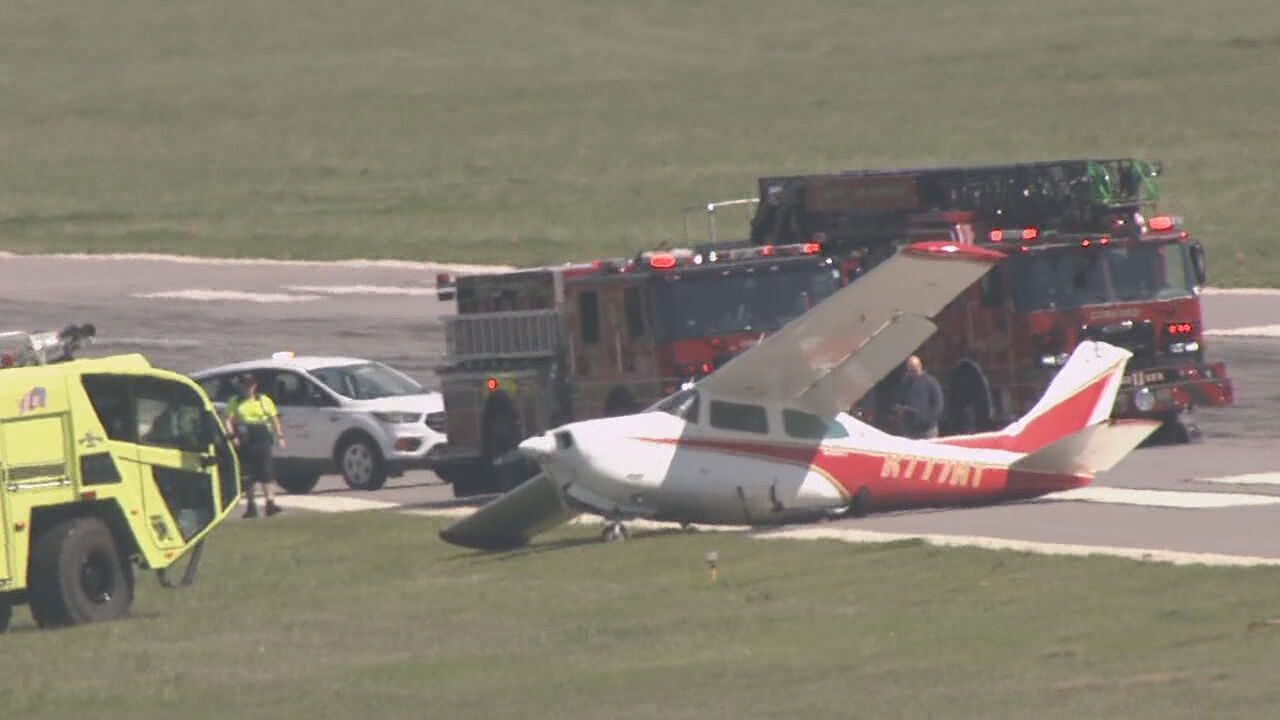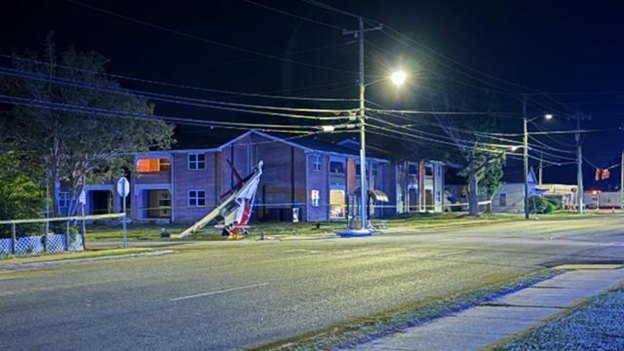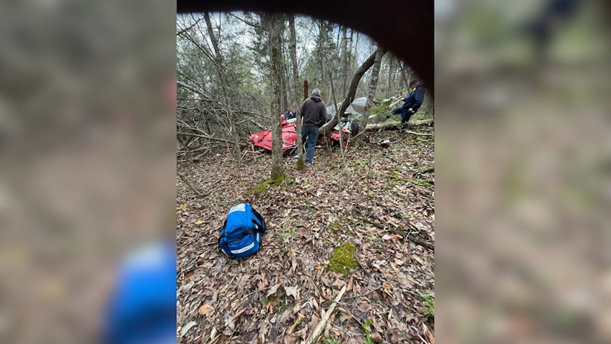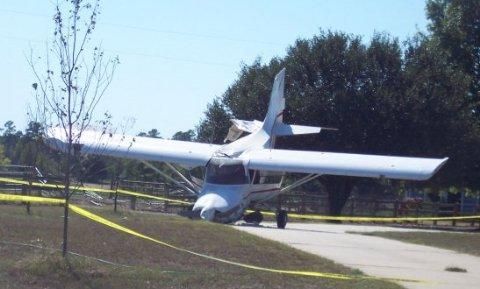ARFF Daily News
Published on:
Monday the 15th of April, 2024
Small plane makes belly landing at Concord airport
By WSOCTV.com News Staff
CONCORD, N.C. — A single-engine plane made an emergency landing after its landing gears failed Friday morning in Concord.
Just after 11 a.m., Chopper 9 Skyzoom captured the Cessna 210L on its approach to Concord-Padgett Regional Airport and it was apparent that its rear landing gears were not operating properly.
The aircraft was descending onto the runway with extended landing gears that appeared to be flailing in the air.
The Cessna, which is registered out of Fort Mill, landed on its belly and skidded to a stop along the side of the runway. Two men, who appeared unharmed, then exited the plane.
It is unclear what caused the landing gear to malfunction.

OCSO: No one hurt as small plane crashes at Holt airport
HOLT, Fla. (WALA) - A Cessna 150 Model S plane was damaged when it flipped during an attempted landing at the Log Lake Airport in Holt, according to the Okaloosa County Sheriff’s Office.
No one was injured during the accident Saturday morning, the agency said.
https://www.fox10tv.com/2024/04/13/ocso-no-one-hurt-small-plane-crashes-holt-airport/

Pilot walks away uninjured from plane crash in Rocky Mount
Authorities said the pilot missed all the power lines and was able to walk away from the crash uninjured.
WRAL Staff
A small plane crashed late Sunday night in Rocky Mount.
The FAA said a single-engine Cessna 172 crashed in Rocky Mount around 9:30 p.m. The Rocky Mount Police Department said the crash happened on West Raleigh Boulevard in between Nashville Road and Edwards Street.
Only the pilot was on board, the FAA said. Authorities said the pilot missed all the power lines and was able to walk away from the crash uninjured.
The FAA and National Transportation Safety Board will investigate the crash.
https://www.wral.com/story/pilot-walks-away-uninjured-from-plane-crash-in-rocky-mount/21380514/

Small plane safely lands without gear in Winter Haven, police say
No injuries and no fuel leak, police say
Brandon Hogan, Digital Editor
WINTER HAVEN, Fla. – A small plane landed Saturday morning at Winter Haven Regional Airport without its landing gear engaged, according to police.
Winter Haven firefighters responded to the runway around 11:15 a.m., the police department said in a statement.
The plane managed to land safely, police said, adding there was no fuel leak nor any other hazardous situations as a result.
No injuries were reported in the landing either, but police could not provide any further information about the aircraft or how many people were on board, the statement reads.
The police department expressed thankfulness that the incident “didn’t evolve into a more serious situation.”
https://www.clickorlando.com/news/local/2024/04/13/small-plane-safely-lands-without-gear-in-winter-haven/

FAA and NTSB to lead Anderson County plane crash investigation
ACSO said pieces of a plane and luggage were found in the Ashley Lane area.
By Avery Jordan
ANDERSON CO., Tenn. (WVLT) -Friday evening, the Anderson County Sheriff’s Office confirmed with WVLT News that an airplane crashed in the woods along Raccoon Valley Road and the Ashley Lane area.
According to the ACSO, at 5:12 p.m., deputies responded to a call in the Tillery Road area to search for plane parts in residences’ yards. Pieces of the plane, along with luggage, were found in the Ashley Lane area as well.
The Anderson County Emergency Management Agency, Claxton Volunteer Fire Department, Anderson County Rescue Squad and Tennessee Highway Patrol Helicopter units collaborated to conduct the search.
Officials with the Federal Aviation Administration confirmed to WVLT News that a single-engine Piper PA-32 crashed around 4:30 E.T.
FAA officials told WVLT News that two people were on board and that the National Transportation Safety Board (NTSB) would assist in leading the investigation.
Officials did not give the condition of the two passengers.
https://www.wvlt.tv/2024/04/13/faa-ntsb-lead-anderson-county-plane-crash-investigation/

Aircraft makes forced landing Friday night on County Road 7
Magnolia Reporter
No one was injured Friday night when an airplane made an emergency landing on Columbia County Road 7.
The aircraft, owned by Henderson State University's aviation program, came to rest in the yard of a residence on the road, which is located southwest of Magnolia Airport.
Henderson State students frequently fly between the Arkadelphia and Magnolia airports as part of their flight training.
The Columbia County Sheriff's Office reported that the pilot lost oil pressure, prompting the emergency landing. The 2007 model Maule MXT7 aircraft nosed over at the end of the landing.
The incident happened about 9 p.m.
https://www.magnoliareporter.com/news_and_business/local_news/article_5215915a-cdfd-11df-ad04-001cc4c002e0.html

NTSB Prelim: Davis DA-3
Airplane Came To Rest Adjacent To A Large Tree About 1.4 Miles South-Southwest Of 80f
Location: Antlers, OK Accident Number: CEN24FA148
Date & Time: April 4, 2024, 16:33 Local Registration: N88DT
Aircraft: Davis DA-3 Injuries: 3 Fatal
Flight Conducted Under: Part 91: General aviation - Personal
On April 4, 2024, about 1633 central daylight time, a Davis DA-3 airplane, N88DT, was destroyed when it was involved in an accident near Antlers, Oklahoma. The pilot and two passengers were fatally injured. The airplane was operated as a Title 14 Code of Federal Regulations Part 91 personal flight.
A witness reported having a brief conversation with the pilot between 1530 and 1600 at the Stan Stamper Municipal Airport (HHW), Hugo, Oklahoma. Afterward, the pilot departed in the accident airplane. The witness reported that the airplane’s departure was uneventful and nothing seemed out of the ordinary with the airplane’s performance during the takeoff.
A second witness observed the airplane arrive at the Antlers Municipal Airport (80F) between 1600 and 1630. Two men met the pilot, and they all boarded the airplane. The pilot subsequently departed toward the south. The takeoff seemed to be routine and there were no obvious anomalies with respect to the airplane. At 1633, local authorities received a report of an explosion. Upon arriving at the site, first responders observed the airplane with an active fire.
The airplane came to rest adjacent to a large tree about 1.4 miles south-southwest of 80F. Multiple smaller trees and low brush was also present at the site. A post-impact fire consumed portions of the fuselage and charred the large tree. Low brush was burned over a large area surrounding the airplane.
The airplane exhibited impact and postimpact fire damage. The forward section of the fuselage and portions of both wings were consumed by the fire. Both wings were separated near the wing roots and located adjacent to the fuselage. The wing fracture surfaces appeared consistent with overstress. The flight controls remained attached to the airframe, and control continuity was confirmed from each control surface to the cockpit area.
The engine was separated from the airframe and resting inverted on the ground near the fuselage. It exhibited localized impact damage. The entire engine was discolored, and a portion of the accessory case was consumed consistent with the postimpact fire. An onscene examination, which included a cylinder borescope evaluation, did not identify any anomalies attributable to a preimpact failure or malfunction. The examination was limited by the extent of the fire damage.
No Automatic Dependent Surveillance – Broadcast (ADS-B) data was identified for the accident flight.
FMI: www.ntsb.gov
NTSB Prelim: Piper PA-32-260
Airplane Had Ascended To An Altitude Of 13,100 Ft MSL And Groundspeed Began To Decay From 118 Knots To 74 Knots
Location: Madras, OR Accident Number: WPR24FA105
Date & Time: March 10, 2024, 15:03 Local Registration: N3264W
Aircraft: Piper PA-32-260 Injuries: 2 Fatal
Flight Conducted Under: Part 91: General aviation - Personal
On March 10, 2024, at 1503 Pacific daylight time, a Piper PA-32-260, N3264W, was destroyed when it was involved in an accident near Madras, Oregon. The pilot and passenger were fatally injured. The airplane was operated as a Title 14 Code of Federal Regulations Part 91 personal flight.
Preliminary Federal Aviation Administration (FAA) Automatic Dependent Surveillance Broadcast (ADS-B) data showed that the flight departed from Aurora State Airport (UAO), Aurora, Oregon, at 1405, and proceeded on an easterly flight path as it ascended to 10,000 ft mean sea level (msl). At 1502 the airplane had ascended to an altitude of 13,100 ft msl and groundspeed began to decay from 118 knots to 74 knots. The data further showed at 1502:10, the airplane was at an altitude of 13,300 msl and entered a descending right turn. The last recorded ADS-B data point was at 1503:28 at an altitude of 4,700 ft msl, about 0.2 miles southwest of the accident site.
At 1503, a power utility company experienced a powerline surge, and sent a crew to investigate. At 1940, the crew discovered wreckage of an airplane, and alerted local authorities.
Two witnesses located about 3 miles northwest of the accident site, reported they observed the airplane descending in a spiraling motion towards the ground. One of the witnesses noted that the airplane was intact at the time. Another witness reported there were rain showers in the area when they heard the loud engine noise of the airplane.
Examination of the accident site revealed that the airplane struck a static wire that spanned between two 100-ft tall high tension powerline towers, and subsequently impacted terrain between the towers. The debris path measured approximately 300 ft from the initial point of impact with the ground and was oriented on an approximate heading of about 130° magnetic.
All the major structural components of the airplane were located within the wreckage debris path. A portion of the static wire was found near the right wing.
The wreckage was recovered to a secure location for further examination.
FMI: www.ntsb.gov
NTSB Prelim: Mooney M20E
While In Cruise Flight In A Gradual Descent, The Airplane’s Two Carbon Monoxide (CO) Detectors Began Alerting
Location: Alpine, AR Accident Number: CEN24LA145
Date & Time: April 2, 2024, 10:56 Local Registration: N86UM
Aircraft: Mooney M20E Injuries: 1 None
Flight Conducted Under: Part 91: General aviation - Personal
On April 2, 2024, about 1056 central daylight time, a Mooney M20E airplane, N86UM, sustained substantial damage when it was involved in an accident near Alpine, Arkansas. The pilot was not injured. The airplane was operated as a Title 14 Code of Federal Regulations Part 91 personal flight.
According to the pilot, while in cruise flight in a gradual descent, the airplane’s two carbon monoxide (CO) detectors began alerting, and he felt symptoms of CO poisoning. The pilot closed the cabin vents, opened a small cockpit window, and attempted to open the door, but was unsuccessful. The pilot decided to not continue the flight to the nearest airport; he shut down the engine and perform a forced landing to a field. During the forced landing, the airplane impacted unsuitable terrain and sustained substantial damage to the forward fuselage.
The airplane was retained for further examination.
FMI: www.ntsb.gov

Today in History
22 Years ago today: On 15 April 2002 an Air China Boeing 767-200 flew into a mountain (CFIT) on approach to Pusan-Kimhae Airport, South Korea, killing 129 out of 166 occupants.
Date: Monday 15 April 2002
Time: 11:21
Type: Boeing 767-2J6ER
Owner/operator: Air China
Registration: B-2552
MSN: 23308/127
Year of manufacture: 1985
Total airframe hrs: 39541 hours
Cycles: 14308 flights
Engine model: Pratt & Whitney JT9D-7R4E4
Fatalities: Fatalities: 129 / Occupants: 166
Aircraft damage: Destroyed, written off
Category: Accident
Location: 4,6 km N of Pusan-Kimhae Airport (PUS) - South Korea
Phase: Approach
Nature: Passenger - Scheduled
Departure airport: Beijing-Capital International Airport (PEK/ZBAA)
Destination airport: Busan-Gimhae (Pusan) International Airport (PUS/RKPK)
Investigating agency: KAIB
Confidence Rating: Accident investigation report completed and information captured
Narrative:
Air China flight 129 departed Beijing at 08:37 on a scheduled flight to Pusan-Gimhae in South Korea. The en route part of the flight was uneventful. At 11:06 the second officer contacted Gimhae Approach. At that moment the airplane was 32 nm from the airport at an altitude of FL170. The approach controller cleared the flight to descend to 6000 feet. Runway 36L was in use and the crew could expect a straight-in approach. at 11:09 the controller notified the crew that the runway was changed to 18R, with winds 210 degrees at 17 kts. This meant a circling approach which none of the crew members had flown yet at Pusan. The captain and first officer then discussed the approach to be flown. The captain cautioned: "We won't enlarge the traffic pattern, the mountains are
all over that side." At 11:13 the flight was further cleared down to 2600 feet. Two minutes later the approach controller radioed: "Air China 129, turn left heading 030 cleared for ILS DME runway 36L, then circle to runway 18 right, report field in sight." At 11:17 they captured the ILS and were cleared further down to the circling altitude of 700 feet. The landing gear was extended and flaps set at 20 degrees. Then the controller instructed the flight to contact Gimhae Tower and to circle west. The second officer responded but did not read back the frequency change. The captain then instructed the first officer to disconnect the autopilot and turn left. From his position in the right hand seat the first officer was able to observe the runway. As the aircraft passed abeam the
runway the autopilot was reengaged with heading select. At that moment the approach controller again contacted flight 129 instructing them to contact
the tower. The crew were busy looking outside to see when they passed abeam the end of the runway. Simultaneously the Gimhae Tower controller contacted
the flight using the emergency frequency. As they passed abeam the threshold at 11:20:02 they started timing to measure the commencement f turning to
base. Eleven seconds after the call on the emergency frequency, the second officer reported to the Tower controller that they were on the circle approach. At 11:20:17 the captain took over control from the first officer and said he was going to turn base. He slowly began a widening turn, causing the first officer to urge him: "turn quickly, not too late." Meanwhile the flight was cleared to land . At 11:20:32 the captain disconnected the autopilot and banked the plane to the right. Twenty-two seconds later the first officer cautioned: "Pay attention to the altitude keeping," and the captain asked him to help him get a visual on the runway. Due to the limited visibility they were not able to see the runway. The first officer then advised the captain to initiate a go around, but the captain did
not respond. At 11:21:15 the first officer said, "Pull up! Pull up!" Pitch attitude was increased to 11.4 degrees but thrust was not increased. Two seconds later the aircraft impacted a mountain, about 4.6 km from the runway.
FINDINGS RELATED TO PROBABLE CAUSES:
1. The flight crew of flight 129 performed the circling approach, not being aware of the weather minima of wide-body aircraft (B767-200) for landing, and in the approach briefing, did not include the missed approach, etc., among the items specified in Air Chinas operations and training manuals.
2. The flight crew exercised poor crew resource management and lost situational awareness during the circling approach to runway 18R, which led them to fly outside of the circling approach area, delaying the base turn, contrary to the captains intention to make a timely base turn.
3. The flight crew did not execute a missed approach when they lost sight of the runway during the circling approach to runway 18R, which led them to strike high terrain (mountain) near the airport.
4. When the first officer advised the captain to execute a missed approach about 5 seconds before impact, the captain did not react, nor did the first officer initiate the missed approach himself.

Mailing Address
Subscribe to our newsletter
Contact Us
We will get back to you as soon as possible.
Please try again later.
